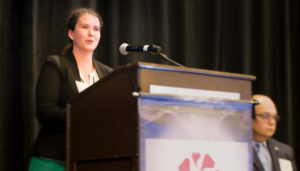HSE&T Corner: Interviewing front-line employees can help identify, eliminate system weaknesses before they manifest as human error
Interviewing front-line employees can help identify, eliminate system weaknesses before they manifest as human error
By Eva Vigh, Editorial Coordinator

Research shows that human error and nonconformance can account for up to 80% of incidents. Of that 80%, up to 70% of incidents can then be attributed to system weaknesses, or conditions that allow an error to occur, said Sandra Adkins, Global Wells Organization Safety Advisor for Human Performance at BP. That means only 30% are related to individual mistakes. And yet, most incident investigations rely on traditional methods, such as near-miss reporting and observation programs, that tend to focus on proximal causes, such as human error. They rarely delve into system weaknesses.
Speaking at the IADC HSE&T Conference in Houston on 6 February, Ms Adkins urged the industry to proactively interview front-line employees about incidents. These are the people whose day-to-day jobs put them at the center of where people, processes and the plant interface, and harnessing their expertise will help to identify and eliminate system weaknesses before they manifest as human error and nonconformance.
“Start thinking about safety interventions a little bit differently… Start looking for weaker signals, deeper back in the organization, and start intervening and speaking up there,” Ms Adkins said. By spotting problems early on, “we can intervene before we ever put someone in place to make a mistake or a bad decision.”
For example, investigations can reveal that a management of change wasn’t thoroughly reviewed or that a risk assessment missed something in the design/planning phase of a well. They can also identify system weaknesses associated with staffing levels and workload. “You might find someone is fatigued, not necessarily because they were irresponsible and not sleeping at night but because we asked them to work 21 days or 28 days in a row,” she said.
To begin the process, Ms Adkins recommends finding a neutral party, such as a third-party or internal consultant who is not in the line management of the interviewees, to conduct the interviews. Next, a cross-section of workers should be selected to be interviewed so that a wide variety of perspectives and ideas are shared. “On a rig, you would want to interview a floor hand, a driller and a rig supervisor, for example,” she said.
It is also important to provide interviewees with questions in advance, she added, as “people will come better prepared and feel less intimidated… and they will realize it’s not a threatening or scary experience and that leadership really just wants to learn.”
There are four main questions that should be asked during these interviews, Ms Adkins recommended. First, the employees should be asked what is going well to support HSE performance – perhaps on the rig, within their crew, at their facility or in their region.
“Take this opportunity to learn about the strengths in your organization,” she said. Interviewers should then ask what are the challenges to achieving even greater HSE performance, as well as what are some specific things that the interviewee hopes will be accomplished with HSE in the future. Lastly, ask them what they would do differently to support HSE if they were in a leadership position.
Open-ended questions and phrases should be used, such as, “tell me more about that” and “describe to me what that looks like.” This creates a comfortable environment for the people being interviewed and can prompt them to provide information that may not initially seem relevant but could be key to identifying system weaknesses.
Once the interviews are complete, the next step is to aggregate the key information obtained so that common themes and trends, as well as specific items requiring immediate action for HSE concerns, can be identified. Interviewers should also work with management to determine the next steps, which can include providing feedback to the interviewees, creating workshops to focus on potential solutions and identifying short- and long-term actions to address issues of concern and support best practices.
The entire procedure, Ms Adkins explained, can be lengthy. “It is labor- and time-intensive. If you interview 10 people, that’s 10 hours, and then you have to sort and digest all that information,” she said. However, it can also go a long way toward helping companies to unearth valuable information to improve HSE. “So much of what impacts incidents, which we call contributing factors, is very subtle. It doesn’t pop out in a regular investigation. We need to dig deeper.” DC





